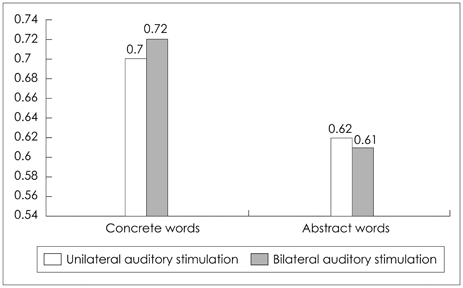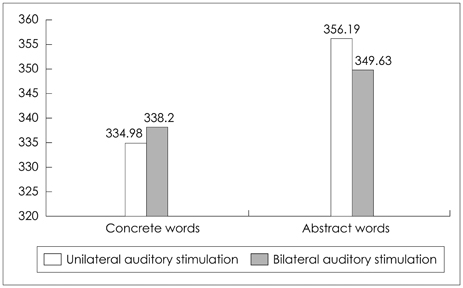J Korean Neuropsychiatr Assoc.
2013 Sep;52(5):353-359.
The Effect of Bilaterally Alternating Auditory Stimulations on the Episodic Memory Retrieval
- Affiliations
-
- 1Department of Psychiatry, Konyang University College of Medicine, Konyang University Hospital, Daejeon, Korea. Cortex@konyang.ac.kr
- 2Center for Brain and Cognition Measurement, Division of Convergence Technology, Korea Research Institute of Standards and Science, Daejeon, Korea.
- 3Department of Medical Physics, University of Science and Technology, Daejeon, Korea.
Abstract
OBJECTIVES
Previous research has shown that bilaterally alternating eye movements enhance episodic memory retrieval. This effect has been considered an important mechanism of the therapeutic effects of eye movement desensitization and reprocessing (EMDR) treatment. We conducted this study in order to test the hypothesis that bilaterally alternating auditory stimuli would also have similar effects on episodic memory retrieval.
METHODS
Thirty eight right-handed subjects participated in this study. Subjects learned words, and then received bilaterally alternating auditory stimuli (as experimental stimuli) or unilateral auditory stimuli (as control stimuli). Subsequently, they performed recognition memory task. Recognition accuracy, response bias, and mean response to hits were used for evaluation of episodic memory retrieval. Repeated measures analysis of variance was performed for statistical analysis.
RESULTS
There was no significant effect of experimental conditions in recognition accuracy, the response bias, and mean response time to hits.
CONCLUSION
Unlike the previous positive results of bilaterally alternating eye movements, we did not observe an enhancing effect of bilaterally alternating auditory stimuli compared to unilateral auditory stimuli on episodic memory retrieval. This result suggests the possibility that the therapeutic mechanisms of EMDR might differ according to modalities of bilateral stimulation.
Keyword
MeSH Terms
Figure
Reference
-
1. Bisson J, Andrew M. Psychological treatment of post-traumatic stress disorder (PTSD). Cochrane Database Syst Rev. 2007; CD003388.
Article2. Shapiro F. Alternative stimuli in the use of EMD(R). J Behav Ther Exp Psychiatry. 1994; 25:89.
Article3. Andrade J, Kavanagh D, Baddeley A. Eye-movements and visual imagery: a working memory approach to the treatment of post-traumatic stress disorder. Br J Clin Psychol. 1997; 36(Pt 2):209–223.
Article4. van den Hout M, Muris P, Salemink E, Kindt M. Autobiographical memories become less vivid and emotional after eye movements. Br J Clin Psychol. 2001; 40:121–130.
Article5. Lee CW, Taylor G, Drummond PD. The active ingredient in EMDR: is it traditional exposure or dual focus of attention? Clin Psychol Psychother. 2006; 13:97–107.
Article6. Christman SD, Garvey KJ, Propper RE, Phaneuf KA. Bilateral eye movements enhance the retrieval of episodic memories. Neuropsychology. 2003; 17:221–229.
Article7. Parker A, Dagnall N. Effects of handedness and saccadic bilateral eye movements on components of autobiographical recollection. Brain Cogn. 2010; 73:93–101.
Article8. Christman SD, Propper RE, Brown TJ. Increased interhemispheric interaction is associated with earlier offset of childhood amnesia. Neuropsychology. 2006; 20:336–345.
Article9. Parker A, Relph S, Dagnall N. Effects of bilateral eye movements on the retrieval of item, associative, and contextual information. Neuropsychology. 2008; 22:136–145.
Article10. Lee BR, Kim JW, Kwon SW, Kwon HC, Kim KW, Kim MY, et al. The influence of bilateral eye movement on recognition memory task performance. J Korean Neuropsychiatr Assoc. 2012; 51:335–341.
Article11. Jeffries FW, Davis P. What is the role of eye movements in eye movement desensitization and reprocessing (EMDR) for post-traumatic stress disorder (PTSD)? A review. Behav Cogn Psychother. 2013; 41:290–300.
Article12. Servan-Schreiber D, Schooler J, Dew MA, Carter C, Bartone P. Eye movement desensitization and reprocessing for posttraumatic stress disorder: a pilot blinded, randomized study of stimulation type. Psychother Psychosom. 2006; 75:290–297.
Article13. van den Hout MA, Engelhard IM, Rijkeboer MM, Koekebakker J, Hornsveld H, Leer A, et al. EMDR: eye movements superior to beeps in taxing working memory and reducing vividness of recollections. Behav Res Ther. 2011; 49:92–98.
Article14. First MB, Spitzer RL, Gibbon M, Williams JBW. Structured Clinical Interview for DSM-IV Axis I disorders, Clinician Version (SCIDCV). Washington, D.C.: American Psychiatric Press, INC.;1996.15. Hahn OS, Ahn JH, Song SH, Cho MJ, Kim JK, Bae JN. Development of Korean version of Structured Clinical Interview Schedule for DSM-IV Axis I disorder: interrater reliability. J Korean Neuropsychiatr Assoc. 2000; 39:362–372.16. Yeom TH, Park YS, Oh KJ, Lee YH. Korean version Wechsler Adult Intelligence Scale. Seoul: Korean Guidance;1992.17. Oldfield RC. The assessment and analysis of handedness: the Edinburgh inventory. Neuropsychologia. 1971; 9:97–113.
Article18. Ransil BJ, Schachter SC. Test-retest reliability of the Edinburgh Handedness Inventory and Global Handedness preference measurements, and their correlation. Percept Mot Skills. 1994; 79:1355–1372.
Article19. Snodgrass JG, Corwin J. Pragmatics of measuring recognition memory: applications to dementia and amnesia. J Exp Psychol Gen. 1988; 117:34–50.
Article20. Kim HS. A reaserch of the usage frequency of Korean Language 2. Seoul: National Institute of the Korean Language;2005. p. 33–692.21. Propper RE, Christman SD. Interhemispheric interaction and saccadic horizontal eye movements: implications for episodic memory, EMDR, and PTSD. J EMDR Prac Res. 2008; 2:269–281.
Article22. Cabeza R, Nyberg L. Imaging cognition II: An empirical review of 275 PET and fMRI studies. J Cogn Neurosci. 2000; 12:1–47.
Article23. Bakan P, Svorad D. Resting EEG alpha and asymmetry of reflective lateral eye movements. Nature. 1969; 223:975–976.
Article24. Morrison-Stewart SL, Velikonja D, Corning WC, Williamson P. Aberrant interhemispheric alpha coherence on electroencephalography in schizophrenic patients during activation tasks. Psychol Med. 1996; 26:605–612.
Article25. Barcaro U, Bonanni E, Denoth F, Murri L, Navona C, Stefanini A. A study of the interhemispheric correlation during sleep in elderly subjects. J Clin Neurophysiol. 1989; 6:191–199.26. Lyle KB, Logan JM, Roediger HL 3rd. Eye movements enhance memory for individuals who are strongly right-handed and harm it for individuals who are not. Psychon Bull Rev. 2008; 15:515–520.
Article27. Luders E, Cherbuin N, Thompson PM, Gutman B, Anstey KJ, Sachdev P, et al. When more is less: associations between corpus callosum size and handedness lateralization. Neuroimage. 2010; 52:43–49.
Article28. Nieuwenhuis S, Elzinga BM, Ras PH, Berends F, Duijs P, Samara Z, et al. Bilateral saccadic eye movements and tactile stimulation, but not auditory stimulation, enhance memory retrieval. Brain Cogn. 2013; 81:52–56.
Article29. Samara Z, Elzinga BM, Slagter HA, Nieuwenhuis S. Do Horizontal Saccadic Eye Movements Increase Interhemispheric Coherence? Investigation of a Hypothesized Neural Mechanism Underlying EMDR. Front Psychiatry. 2011; 2:4.
Article30. Propper RE, Pierce J, Geisler MW, Christman SD, Bellorado N. Effect of bilateral eye movements on frontal interhemispheric gamma EEG coherence: implications for EMDR therapy. J Nerv Ment Dis. 2007; 195:785–788.
Article31. van den Hout MA, Rijkeboer MM, Engelhard IM, Klugkist I, Hornsveld H, Toffolo MJ, et al. Tones inferior to eye movements in the EMDR treatment of PTSD. Behav Res Ther. 2012; 50:275–279.
Article32. Shapiro F. The EMDR approach to psychotherapy: EMDR humanitarian assistance program basic training course. Watsonville, CA: EMDR Institute;2008.
- Full Text Links
- Actions
-
Cited
- CITED
-
- Close
- Share
- Similar articles
-
- The Effect of Bilateral Eye Movements on Emotional Face Recognition Memory Task
- Functional Mapping of the Neural Basis for the Encoding and Retrieval of Human Episodic Memory Using H215O PET
- The Changes of Reaction Time to Visual and Auditory Stimulations during Propofol Administration for Conscious Sedation
- Brain Mapping for Memory and Learning
- Brain Mapping of Episodic Memory in Patients with Medial Temporal Lobe Epilepsy Using Activation Positron Emission Tomography



